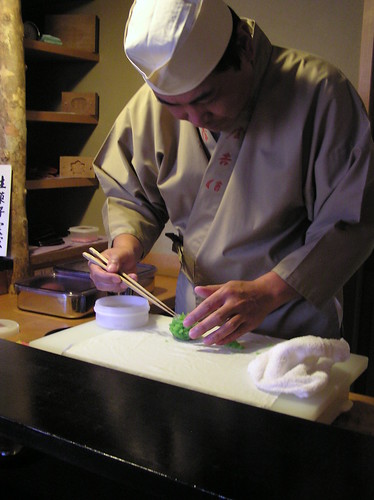
Day forty-four: Jōnamagashi /上生菓子
7jyo-Kanshundo, ¥2100 for 4 sweets and lesson
Tsuruya Yoshinobu, ¥800 for sweet and tea
Of the many different ways of categorizing the range of Japanese sweets (wagashi), one of the most prevalent is the division between higashi, "dry" sweets with a low moisture content and a relatively long shelf life, and namagashi, sweets that are fresh, raw, or "rare" (in the bloody steak sense). Out of the moisture content criterion grow other, less quantifiable characteristics, with namagashi tending to be more seasonal, more artisanal, and more expensive.
Jōnamagashi, then, are the freshest of the fresh, soft, sweet symbols of the present moment, tenderly made by hand, and, ideally, eaten immediately thereafter. Kyoto is famous for its namagashi makers, a few of whom also offer tourists the rare opportunity to try their own hand at jōnamagashi.
The Gion branch of Shichijyo-Kanshundo offers regular classes to groups of any size who book ahead. The lesson takes between 60 and 90 minutes, and since the materials are ready and waiting, is less a cooking class than a sculpture workshop. For ¥2100 you get the lesson, enough raw materials to make 4 sweets, a cup of matcha with which to wash down your ugliest creation, and boxes for all the rest. Not bad at all when you consider that the sweets themselves could cost ¥300-450 each. Jōnamagashi, then, are the freshest of the fresh, soft, sweet symbols of the present moment, tenderly made by hand, and, ideally, eaten immediately thereafter. Kyoto is famous for its namagashi makers, a few of whom also offer tourists the rare opportunity to try their own hand at jōnamagashi.
I talked my hostess Miko and one of her friends in coming with me and they were good sports and great translators. The class took place around a low table in a tatami room on the top floor of what must have been an old house. Our teacher, Suganuma-sensei, was a surprisingly young man with a ponytail like a long silk tassel trailing from under his uniform cap (below, left).
Sensei got us started on the sweet in the foreground of the picture above, "Hanano" (花野). The exterior is nerikiri, a mixture of gyuhi (a more delicate, less common cousin of mochi) and shiroikoshian (smooth white bean paste) that's as smooth and elastic as Play-doh, and as dyable as those white satin prom shoes. After watching sensei turn out a perfect example, we each started in on a large green ball, adding a yellow section by smoothing the perimeter of a flattened yellow ball onto the green, then rolling the thing between our palms to make it spherical again. The we flattened it out, placed a ball of red bean paste in the center, and stretched and coaxed the nerikiri until it completely enrobed the core (below, center). We pressed three small pink dots onto the top, then held the ball aloft and upside down, draping a damp cheesecloth over it. Finally, we brought the ends of the cloth together at the top center of the ball and twisted gently (this technique is called "chakin shibori") while giving the bunched cloth a three-fingered pinch.
We also made "Kikuyo", a deep purple Chinese bellflower, and "Shukaidou", a haystack of kinton extruded through a bamboo screen and gently arranged over a ball of tsubuan paste. Everyone was very complimentary about my output and I may or may not have mentioned that this was not my first attempt at sculpting jōnamagashi. When the ladies explained the extent of my love for wagashi, Suganuma-sensei gave me one of the sculpting tools that he had carved himself from aged bamboo.
I was still feeling a little full of myself the next day, when I headed over to Tsurya Yoshinobu's beautifully appointed jonamagashi "bar" with Oya, a new friend and fellow enthusiast. For ¥800 you choose one of a small selection of sweets, then belly up to the bar as the master on the other side does a low-key Benihana routine (below, right). As you watch he creates complicated and poetic seasonal sweets; mine depicted a just-opened chrysanthemum stuffed with cotton wool, an old aristocratic method of collecting perfume to tuck into their kimonos. The impassive wagashi maker went about his work with balletic grace and a minimum of fuss as I sat, elbows on the bar, mouth hanging open, savoring just how easy he made it look.





No comments:
Post a Comment